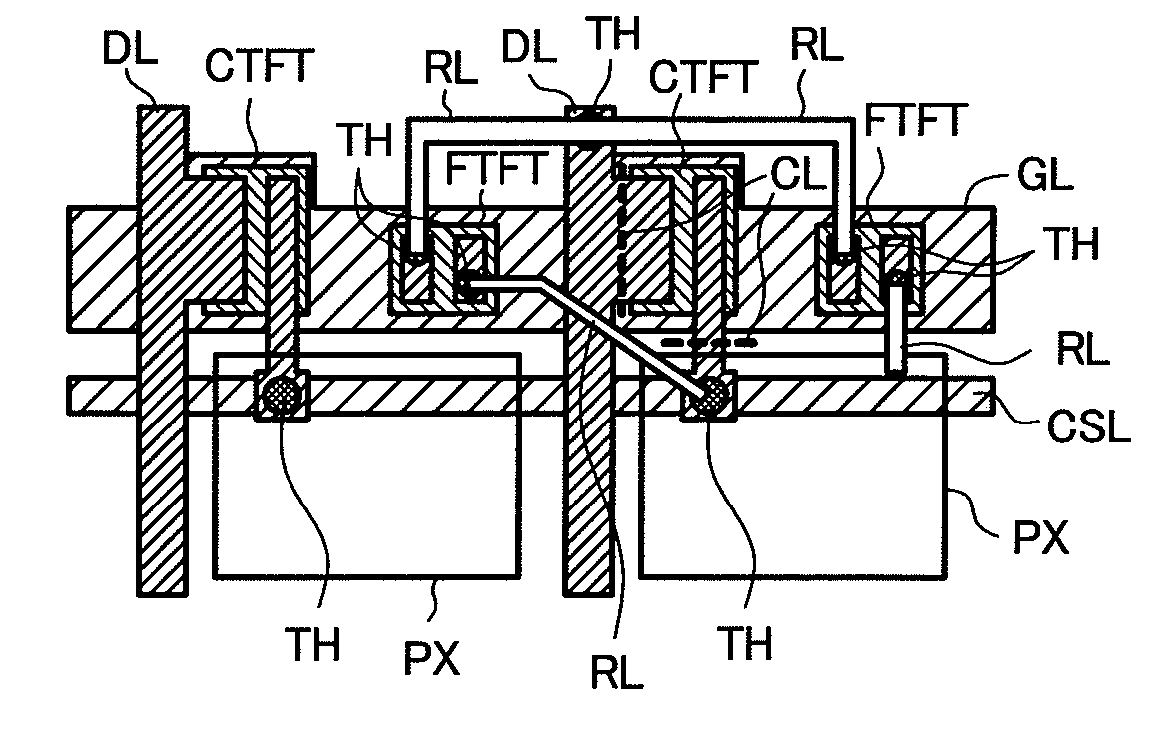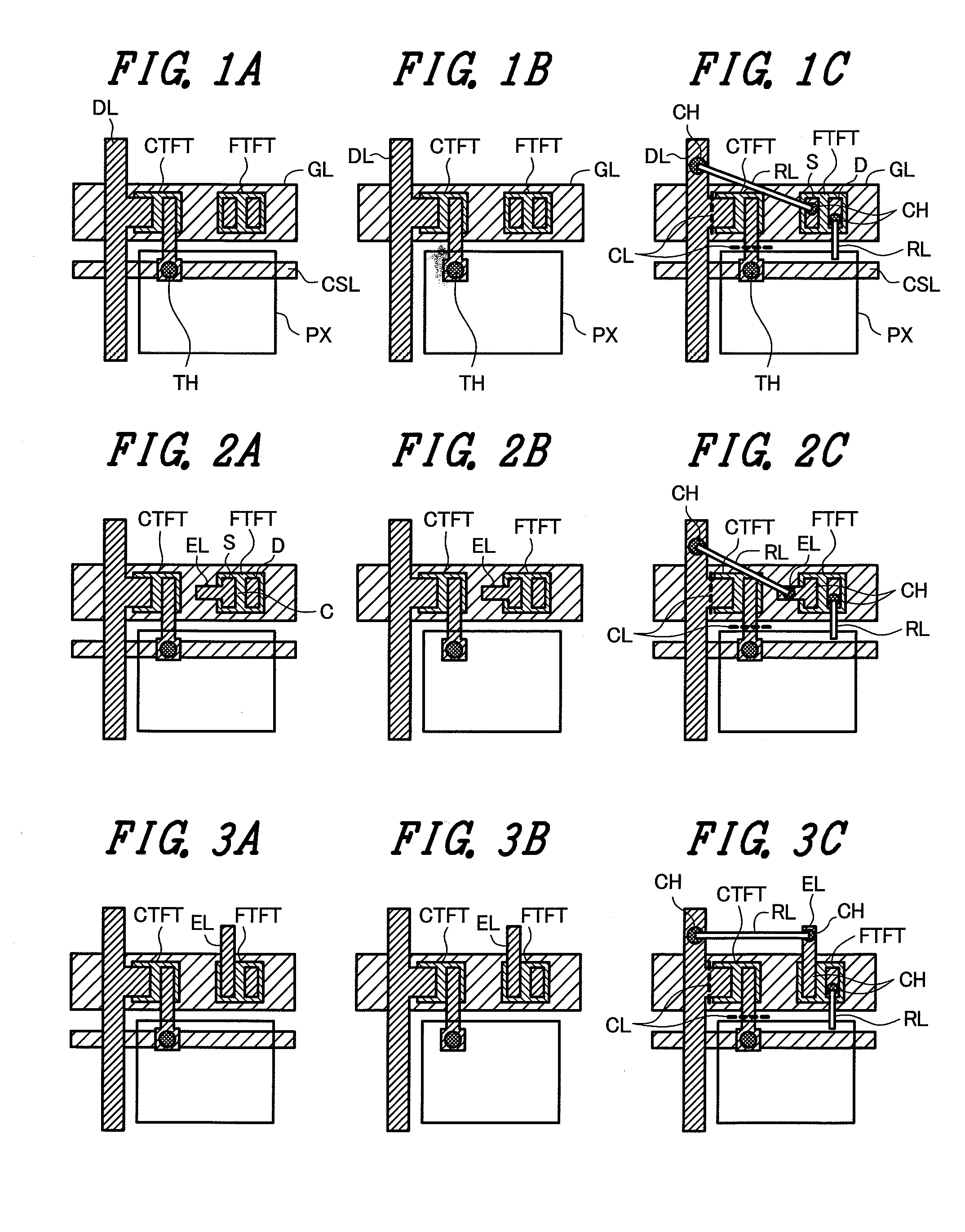Liquid Crystal Display Device
a liquid crystal display and thin film transistor technology, applied in non-linear optics, instruments, optics, etc., can solve problems such as inconvenient repair of transistors, black spot defects, and bright spot defects, and achieve the effect of easy repair and maintenan
- Summary
- Abstract
- Description
- Claims
- Application Information
AI Technical Summary
Benefits of technology
Problems solved by technology
Method used
Image
Examples
third embodiment
[0052]FIGS. 3A to 3C are configural diagrams of the pixel portion of the present embodiment. What is different from the second embodiment shown in FIGS. 2A to 2C is that the leader line EL for repair connection is led out as far as the outside of the gate line GL. FIGS. 3A, 3B, and 3C correspond to FIGS. 2A, 2B, and 2C, and description of the same reference letters will be omitted.
[0053] Turning now to FIGS. 3A to 3C, a heat process such as laser CVD is used in the formation of the contact holes CH and in the connection of the repair lines RL when the spare transistor FTFT is to be connected to the data signal line DL and the pixel electrode PX. For that reason, when the leader line EL is disposed on the gate line GL and the contact hole CH is formed as in the second embodiment, there is the potential for the insulating film between the leader line EL and the gate line GL to be destroyed by heat. Thus, in the present embodiment, the leader line is led out as far as the outside of t...
fourth embodiment
[0055]FIGS. 4A to 4C are configural diagrams of the pixel portion of the present embodiment. What is different from the second and third embodiments shown in FIGS. 2A to 2C and FIGS. 3A to 3C is that it is ensured that leader lines EL do not intersect the pixel electrode PX and the holding capacity line CSL. FIGS. 4A, 4B, and 4C correspond to FIGS. 2A, 2B, 2C and FIGS. 3A, 3B, and 3C, and description of the same reference letters will be omitted.
[0056] Turning now to FIGS. 4A to 4C, when a leader line EL from the drain electrode D of the spare transistor FTFT planarly intersects the pixel electrode PX, parasitic capacitance between the pixel electrode PX (or the drain electrode D) and the gate line GL becomes larger, which causes a problem in the uniformity of display within the screen. Thus, in the present embodiment, when the leader line EL is formed in the direction of the pixel electrode PX, the leader line EL does not planarly intersect the pixel electrode PX. Similarly, the l...
fifth embodiment
[0057]FIGS. 5A to 5C are configural diagrams of the pixel portion of the present embodiment. What is different from the embodiments heretofore is that the leader lines EL from the spare transistor FTFT planarly intersect both the data line DL and the pixel electrode PX, but they are placed in a floating state where they are not connected in terms of direct current. FIGS. 5A, 5B, and 5C correspond to A, B, and C of the heretofore figures, and description of the same reference letters will be omitted.
[0058] Turning now to FIGS. 5A to 5C, a floating metal FM is in the same layer as the gate line GL and planarly intersects the data signal line DL via an insulating layer. The leader line EL from the spare transistor FTFT and the data signal line DL are in the same layer and overlap the floating metal FM via the insulating film. As shown in FIG. 5C, this overlapping portion is capable of being connected by laser spots LS that have been heat-welded utilizing a laser or the like, so that c...
PUM
| Property | Measurement | Unit |
|---|---|---|
| angle | aaaaa | aaaaa |
| angle | aaaaa | aaaaa |
| angle | aaaaa | aaaaa |
Abstract
Description
Claims
Application Information
 Login to View More
Login to View More - R&D
- Intellectual Property
- Life Sciences
- Materials
- Tech Scout
- Unparalleled Data Quality
- Higher Quality Content
- 60% Fewer Hallucinations
Browse by: Latest US Patents, China's latest patents, Technical Efficacy Thesaurus, Application Domain, Technology Topic, Popular Technical Reports.
© 2025 PatSnap. All rights reserved.Legal|Privacy policy|Modern Slavery Act Transparency Statement|Sitemap|About US| Contact US: help@patsnap.com



